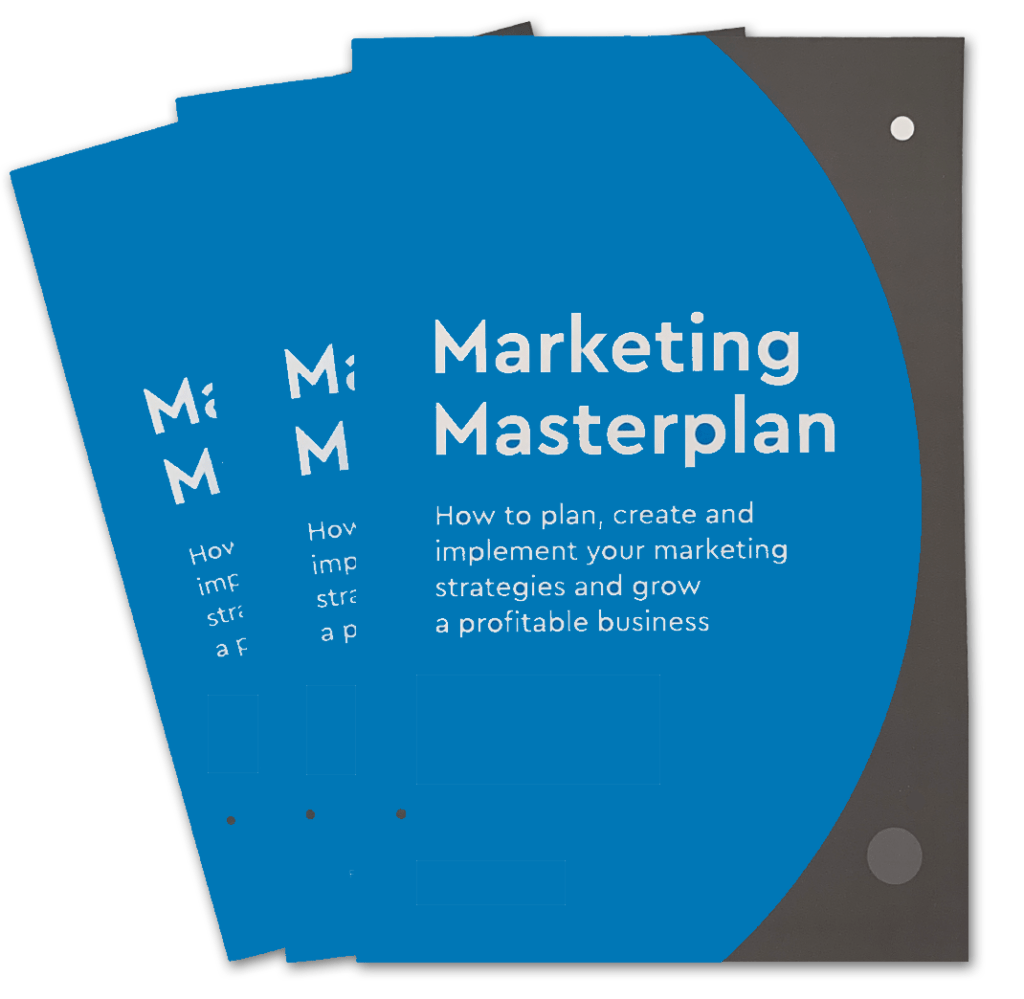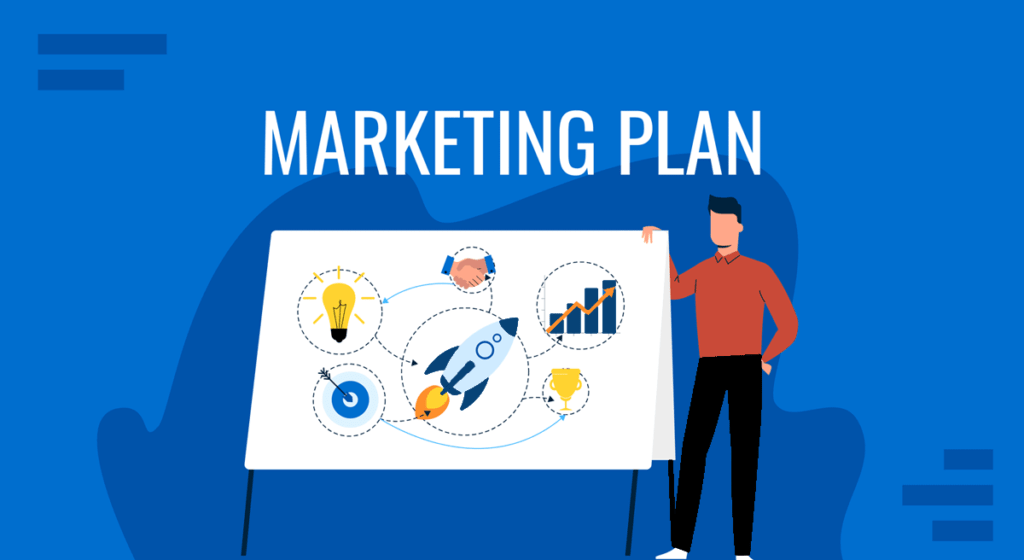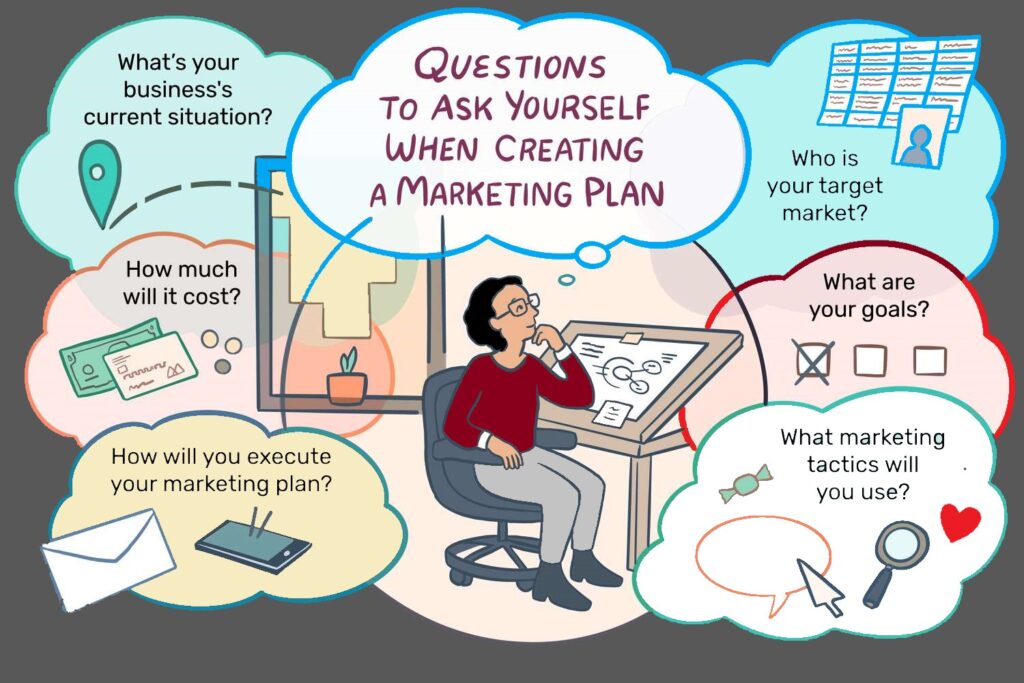A marketing plan is the roadmap that guides businesses through promoting their products and services effectively to a target audience. It defines the goals, strategies, and tactics needed to succeed in a competitive marketplace.

Whether you’re running a startup or a large corporation, an outstanding marketing plan can help you allocate resources efficiently, define priorities, and achieve measurable results.
This article will walk you through five essential steps for creating an outstanding marketing plan, explain what a high-level marketing plan includes, and provide various templates you can use to simplify the process.
Table of Contents
What a High-Level Marketing Plan Includes
A high-level marketing plan serves as a strategic roadmap, outlining the overarching goals and approaches a business will take to succeed in its marketing efforts.
It is designed to provide clarity on direction without going into granular details, making it essential for aligning teams and stakeholders on the business’s marketing trajectory.

Here’s a deeper dive into each of the components, along with examples for better understanding:
- Business Summary: This offers a snapshot of the company, its mission, vision, and core values, along with its products or services.
- Example: If you run a sustainable clothing brand, your business summary might mention your commitment to eco-friendly materials, your target market of environmentally-conscious consumers, and your mission to reduce fashion waste.
- Example: If you run a sustainable clothing brand, your business summary might mention your commitment to eco-friendly materials, your target market of environmentally-conscious consumers, and your mission to reduce fashion waste.
- SWOT Analysis: This analyzes the internal strengths and weaknesses of the company as well as external opportunities and threats in the market.
- Example: A tech startup might list strengths like innovative products and a dynamic team, but weaknesses like a lack of brand recognition. Opportunities could include a growing market, while threats might be competition from established tech giants.
- Example: A tech startup might list strengths like innovative products and a dynamic team, but weaknesses like a lack of brand recognition. Opportunities could include a growing market, while threats might be competition from established tech giants.
- Business Initiatives: These are specific marketing objectives for a set period, such as launching a new product or entering a new market.
- Example: A cosmetics company may set initiatives like increasing brand awareness by 20% in a new market segment or introducing an eco-friendly product line in the next quarter.
- Example: A cosmetics company may set initiatives like increasing brand awareness by 20% in a new market segment or introducing an eco-friendly product line in the next quarter.
- Customer and Competitor Analysis: This involves understanding the demographics, behaviors, and needs of the target audience, and researching competitors to identify advantages or gaps.
- Example: For an online fitness service, the customer analysis might reveal that busy professionals seek convenient, home-based fitness solutions. Competitor analysis might show that no other major competitor is focusing on short, high-intensity workouts, presenting an opportunity.
- Example: For an online fitness service, the customer analysis might reveal that busy professionals seek convenient, home-based fitness solutions. Competitor analysis might show that no other major competitor is focusing on short, high-intensity workouts, presenting an opportunity.
- Market Strategy: This component covers the 4Ps (Product, Price, Place, Promotion) and how the business plans to position its products in the market.
- Example: An organic food company might decide to price its products slightly higher than conventional options to reflect its premium quality, promote through social media influencers, and sell directly to consumers via an e-commerce platform.
- Example: An organic food company might decide to price its products slightly higher than conventional options to reflect its premium quality, promote through social media influencers, and sell directly to consumers via an e-commerce platform.
- Budget: This outlines the financial resources allocated to each marketing activity, ensuring that the plan is financially viable.
- Example: For a holiday campaign, a retail brand may allocate 40% of the budget to digital ads, 30% to influencer marketing, and the remaining 30% to in-store promotions.
- Example: For a holiday campaign, a retail brand may allocate 40% of the budget to digital ads, 30% to influencer marketing, and the remaining 30% to in-store promotions.
- Marketing Channels: These are the platforms and avenues (social media, marketing emails, TV, etc.) where the business will promote its products or services.
- Example: A tech gadget company might focus on Instagram, YouTube, and tech blogs to reach its tech-savvy audience.
- Example: A tech gadget company might focus on Instagram, YouTube, and tech blogs to reach its tech-savvy audience.
- Marketing Technology: This includes software and tools that help manage campaigns, analyze data, and automate processes (e.g., CRM systems, email marketing platforms).
- Example: A business may use a software to track customer interactions, Google Analytics for website performance, and Hootsuite for managing social media posts.
- Example: A business may use a software to track customer interactions, Google Analytics for website performance, and Hootsuite for managing social media posts.
By including these elements, the high-level marketing plan ensures a strategic approach that can guide day-to-day marketing operations while keeping the business’s broader objectives in focus.
Creating a Marketing Plan
There are six critical questions that can guide the creation of a comprehensive marketing plan. These questions help structure the planning process and ensure that all key areas are covered:
- What’s your business’s current situation?
- This question helps you assess your business’s position in the market. It involves understanding your market share, current product offerings, and brand perception. Analyzing this can set a solid foundation for your marketing efforts.
- This question helps you assess your business’s position in the market. It involves understanding your market share, current product offerings, and brand perception. Analyzing this can set a solid foundation for your marketing efforts.
- Who is your target market?
- Knowing your target audience is essential for tailoring marketing strategies. Defining demographics, interests, and behaviors helps to better position your products or services to meet their needs and expectations.
- Knowing your target audience is essential for tailoring marketing strategies. Defining demographics, interests, and behaviors helps to better position your products or services to meet their needs and expectations.
- What are your goals?
- Setting clear objectives (like increasing brand awareness or boosting sales) is vital. These goals provide a direction for your marketing plan and help measure success.
- Setting clear objectives (like increasing brand awareness or boosting sales) is vital. These goals provide a direction for your marketing plan and help measure success.
- How much will it cost?
- Budgeting is a crucial part of any marketing plan. Estimating costs helps allocate resources to the most effective strategies while keeping your marketing efforts financially viable.
- Budgeting is a crucial part of any marketing plan. Estimating costs helps allocate resources to the most effective strategies while keeping your marketing efforts financially viable.
- How will you execute your marketing plan?
- This step involves detailing the actions, tactics, and channels you’ll use to implement the marketing plan. It focuses on the logistics of how campaigns will be launched and managed.
- This step involves detailing the actions, tactics, and channels you’ll use to implement the marketing plan. It focuses on the logistics of how campaigns will be launched and managed.
- What marketing tactics will you use?
- Different tactics, such as social media, email marketing, or influencer partnerships, are crucial for reaching your audience. Choosing the right mix of strategies ensures that your marketing message resonates and drives results.
- Different tactics, such as social media, email marketing, or influencer partnerships, are crucial for reaching your audience. Choosing the right mix of strategies ensures that your marketing message resonates and drives results.

These questions guide a business in aligning its marketing objectives with practical steps, ensuring a well-rounded and effective marketing plan.
How to Create a Marketing Plan
Creating an effective marketing plan involves systematic steps to ensure that your marketing efforts are aligned with your business objectives. Below is a five-step guide to creating a successful marketing plan.
Step 1: Conduct a Situation Analysis
Before diving into marketing strategies and tactics, it’s essential to perform a situation analysis to understand the internal and external factors influencing your business.
- SWOT Analysis: Conduct a SWOT analysis to identify your company’s strengths, weaknesses, opportunities, and threats.
- Strengths: What do you excel at? This could include product quality, customer service, or brand recognition.
- Weaknesses: What are your current limitations? For example, low brand awareness or limited resources.
- Opportunities: What market trends or opportunities can you take advantage of?
- Threats: Identify external factors like competitors or market changes that could affect your business.
- Strengths: What do you excel at? This could include product quality, customer service, or brand recognition.
- Competitor Analysis: Analyze your direct competitors’ strategies to identify areas where you can differentiate yourself.
- Market Research: Use market research to understand your industry trends, consumer behaviors, and potential market growth. This information will provide a solid foundation for your marketing plan.
Step 2: Define Your Target Audience
The success of your marketing plan largely depends on how well you understand your target audience. Defining your audience allows you to craft personalized messages that resonate with them, ultimately improving the effectiveness of your campaigns.
- Customer Segmentation: Break down your audience into segments based on demographics, psychographics, behaviors, or geographic location. This allows you to target specific groups with tailored messaging.
- Buyer Personas: Create detailed buyer personas that reflect your ideal customers. These personas should include age, gender, occupation, income level, hobbies, and buying behaviors.
- Customer Pain Points: Identify the problems or challenges that your target audience is facing and position your products or services as the solution.
Step 3: Write SMART Goals
Your marketing goals should be clear, measurable, and aligned with your business objectives. SMART goals are an effective way to structure your marketing plan goals:
- Specific: Clearly define what you want to achieve. For example, “Increase brand awareness among millennial consumers.”
- Measurable: Set measurable outcomes, such as “Increase website traffic by 20%.”
- Achievable: Make sure the goals are realistic and attainable based on your resources.
- Relevant: Ensure your goals align with your overall business objectives.
- Time-bound: Set a timeframe for achieving your goals, such as “within the next six months.”
Step 4: Analyze Your Tactics
Marketing tactics are the specific methods you employ to execute your marketing strategy and reach your objectives. Each tactic focuses on engaging your target audience, building brand awareness, or converting leads into customers.
Here’s a deeper breakdown of the tactics mentioned:
- Content Marketing:
This involves creating and distributing valuable, relevant content to attract your audience. It’s a long-term strategy where you produce blogs, videos, infographics, or e-books to educate or entertain your audience.
The goal is to provide value, build trust, and eventually guide the audience toward your product or service. Consistent, high-quality content can position your brand as a thought leader and help with SEO efforts. - Social Media Marketing:
Social media platforms like Facebook, Instagram, LinkedIn, and Twitter offer spaces to interact with potential customers. These platforms allow businesses to share content, engage directly with their audience, and promote products in a more casual, relatable way.
It’s also great for building communities around your brand and leveraging user-generated content. Paid social advertising can further amplify your reach by targeting specific demographics. - Email Marketing:
Email marketing is about sending tailored, direct messages to your audience’s inboxes. These campaigns can nurture leads by providing them with valuable content or updates, and ultimately drive conversions through promotional offers, product launches, or newsletters.
By personalizing your emails based on user behavior or preferences, you can build deeper relationships and encourage actions like purchases or subscriptions. - Paid Advertising (PPC):
Pay-Per-Click campaigns like Google Ads or Facebook Ads allow businesses to pay only when users click on their ads. This tactic helps you target specific keywords or demographic groups, ensuring your ads are shown to relevant audiences.
PPC provides fast results and is great for driving traffic quickly to your website, especially for specific campaigns like product launches, promotions, or events. - SEO (Search Engine Optimization):
SEO is about improving your website’s visibility on search engines like Google. By optimizing your content and website structure for relevant keywords, you can attract organic traffic.
This means ensuring your site is user-friendly, loads quickly, has quality backlinks, and includes optimized content. A higher ranking in search results can increase credibility and drive long-term, sustainable traffic without ongoing ad spend.
Each tactic works best when integrated with your broader marketing strategy and aligned with your business goals and target audience preferences.
Step 5: Set Your Budget
The final step in creating your marketing plan is setting a budget that outlines how much you’ll spend on each tactic. Your budget should be realistic and take into account factors such as ad spend, content creation costs, software fees, and marketing technology investments.
Consider allocating your budget across the following categories:
- Paid Advertising: Costs associated with PPC ads, social media ads, and sponsored content.
- Content Creation: Expenses for creating high-quality content such as blogs, videos, and infographics.
- Tools and Software: Investments in marketing automation platforms, CRM systems, and analytics tools.
- Outsourcing: If you outsource any aspect of your marketing (e.g., graphic design or social media management), include those costs in your budget.
Marketing Plan Templates You Can Use
To streamline the process, you can use various marketing plan templates that provide a structured framework. Below are some popular templates to consider.
Simplified Marketing Plan Template
For businesses looking for a quick and easy solution, a simplified marketing plan template covers the essentials:
- Business Summary: Briefly describe your business and the products or services you offer.
- Target Market: Define the key audience you want to reach.
- Marketing Goals: Identify measurable goals, such as increasing website traffic or boosting social media engagement.
- Budget: Allocate your budget for marketing activities.
- Marketing Channels: Choose the platforms you will use to execute your marketing campaigns.
Digital Marketing Plan Template
A digital marketing plan template focuses on the digital channels and strategies you will use to reach your audience. It includes sections like:
- Business Objectives: Outline what you aim to achieve through digital marketing.
- SEO Strategy: Plan your search engine optimization efforts to improve website visibility.
- PPC Strategy: Define the pay-per-click campaigns you’ll run on platforms like Google Ads.
- Email Campaigns: Map out your email marketing strategy, including list segmentation and drip campaigns.
- Social Media Strategy: Identify the social media channels you’ll use and the type of content you’ll post.
Social Media Marketing Plan Templates
A social media marketing plan helps you define how you’ll use social media to grow your business. Use this template to guide your social media marketing strategy:
- Social Media Goals: Define your goals, such as increasing followers, boosting engagement, or driving website traffic.
- Target Audience: Segment your social media audience based on platform preferences, interests, and demographics.
- Content Calendar: Create a schedule for posting across different social media channels.
- Paid Social Media: Outline your ad campaigns on platforms like Facebook, Instagram, and LinkedIn.
- Social Media Audit: Assess your current social media performance and identify areas for improvement.
Marketing Plan Outline
A more detailed marketing plan outline should include the following key sections:
- Business Summary: Include an overview of your company, mission statement, and core values.
- SWOT Analysis: Highlight your strengths, weaknesses, opportunities, and threats.
- Business Initiatives: Define your short-term and long-term marketing initiatives.
- Customer Analysis: Provide a detailed analysis of your target market, including buyer personas.
- Competitor Analysis: Assess your key competitors, their strengths, weaknesses, and market positioning.
- Market Strategy: Describe your product, pricing, promotion, and placement strategies.
- Budget: Allocate your marketing budget across channels and campaigns.
- Marketing Channels: Define the platforms and channels you’ll use to reach your audience.
- Marketing Technology: List the tools and platforms you’ll use to manage, track, and optimize your marketing efforts.
Marketing Plan Timeline
A marketing plan timeline lays out when each element of your plan will be executed. For instance:
- Month 1: Conduct situation analysis, define target audience, and finalize marketing goals.
- Month 2: Implement content marketing strategies, launch social media campaigns, and monitor performance.
- Month 3: Evaluate progress, optimize tactics, and adjust the budget as necessary.
One-Page Marketing Plan Template
For smaller businesses or startups, a one-page marketing plan offers a concise but actionable guide.
- Business Summary: A brief description of your company and products/services.
- Target Market: An overview of your ideal customer and market segment.
- Budget: Estimated costs for marketing initiatives.
- Marketing Channels: Platforms you’ll use to reach your target audience.
Marketing Campaign Template
A marketing campaign template outlines the specific campaigns you’ll run to achieve your marketing goals. It should include:
- Campaign Objective: The primary goal of the campaign (e.g., increase leads or drive traffic).
- Target Audience: Who you aim to reach with the campaign.
- Campaign Timeline: Start and end dates of the campaign.
- Marketing Channels: Platforms where the campaign will run (e.g., Google Ads, Facebook, etc.).
- Budget: The estimated cost for executing the campaign.
Start the Marketing Planning Process Today
Marketing is constantly evolving, so it’s essential to be adaptable. Below are additional tools and templates to help with specialized aspects of your marketing plan.
Social Media Questions
Create a list of essential questions to guide your social media marketing strategy. These can include questions like “What platforms are my target audience most active on?” or “What type of content does my audience engage with?”
Facebook Live Schedule
Plan out your Facebook Live sessions, including dates, times, and topics to ensure consistent engagement with your audience.
Instagram Post Log
Track your Instagram posts, including captions, hashtags, engagement rates, and audience feedback.
Paid Social Media Template
Plan and track your paid social media campaigns, including the budget, audience targeting, and ad performance.
Social Media Audit
Evaluate your current social media performance, including growth in followers, engagement rates, and campaign effectiveness.
Social Media Editorial Calendar
Plan your social media content for weeks or months in advance. This will help ensure consistency and enable you to schedule content around important dates or campaigns.
Social Media Image Sizes
Ensure your images are optimized for each platform by following recommended image size guidelines for Facebook, Instagram, Twitter, LinkedIn, and others.
Social Media Marketing Proposal
Create a formal proposal for your social media marketing initiatives. Include goals, target audience, strategy, and expected outcomes.
Social Media Reporting Template
Track and analyze the results of your social media campaigns using a comprehensive reporting template. This should include data such as impressions, clicks, conversions, and engagement rates.
Closing Remarks
Creating an outstanding marketing plan requires careful planning, analysis, and execution. By following the five-step process outlined above, businesses can develop a robust marketing strategy that aligns with their business objectives.
With the use of various templates—such as digital marketing, social media, and one-page plans—businesses can simplify the process and ensure that every aspect of their strategy is covered.
The marketing landscape is constantly evolving, but with the right plan in place, businesses can adapt to changes and continue to reach their target audience effectively.
Start your marketing planning process today by using the templates provided, setting SMART goals, and conducting a thorough analysis of your market and competition.







